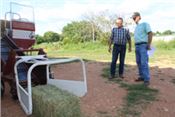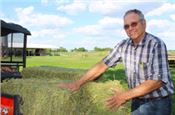|
SW Missouri Hay Producer Finds Nich Market For High-Quality Small Bales

University of Missouri Extension agronomist Tim Schnakenberg, right, checks out Obermann's
self-propelled hay wagon, which minimizes handling and eases the workload.
Photo credit: Linda Geist
MONETT, MO.
Glenn Obermann has a winning recipe for quality hay. At the 2018 Missouri State Fair, Glenn and Toni Obermann took Champion and Reserve Champion awards in alfalfa and grass classes 4-8, and Champion in alfalfa classes 1-3. The Obermanns entered the fair with championship awards in seven of eight years since 2010.
University of Missouri Extension forage specialist Tim Schnakenberg says Obermann’s attention to detail and timing combine for consistently superior hay.
The Obermann hay posted relative forage quality (RFQ) scores of 234.5 and protein of 22.7 percent. U.S. Department of Agriculture guidelines consider RFQ above 185 to be the highest class-supreme.
The Obermanns mix quality forage with time-tested, research-based agricultural and production practices to achieve high scores in RFQ, TDN (total digestible nutrients) and RFV (relative feed value).
Their wall of ribbons continues to grow. At the recent Ozark Empire Fair Hay Show in Springfield, they took champion honors in the dry hay show in legumes with a mix of WL alfalfa and Crown Royale orchardgrass. It tested at 234.5 RFQ and 60.14 TDN. They have won top honors five of the last nine years.
Obermann says he relies on MU Extension to teach him about university research and practices. He regularly attends workshops and has been a tour host for extension events.
Southwestern Missouri is hay and cattle country. Due to low water reserves in 2017 followed by a crippling lack of precipitation in 2018, some producers began dipping into dry hay supplies early this year and are scrambling to find high-quality hay to buy. Obermann says he gets six or seven calls daily from producers whose drought-stressed hayfields are producing only a third to half their normal amounts this year.
Half of Obermann’s hay is alfalfa. The other half is an alfalfa-orchardgrass mix. He owned a dairy herd until 2010 before finding a niche market for high-quality alfalfa in small bales. This market includes cattle, horse, sheep, goat, llama and alpaca owners. He misses raising cattle, but he found he needed to devote all of his efforts to quality hay.
As an ex-dairyman, Obermann knows what livestock owners want in their hay. “The people who win hay shows are dairymen,” says MU Extension livestock specialist Eldon Cole. “They know quality hay and realize if they are going to get performance, the forage is critical. His reputation is good and he prices fairly based upon the current market.”
Obermann’s 90 acres produced 14,000 bales on five cuttings in 2017. The rest of his 200-acre farm is in a rotation of wheat and soybean, and he also raises straight grass hay. In a few areas, he cut six times. Like other growers, he expects less this year. In 2016 and 2017, good rains in the May-August period boosted cuttings. In the 2012 drought, he got two early cuttings before the rain shut off.
He gets an average of five cuttings per season, baling to Dec. 1 after a killing frost. Schnakenberg says conventional hay baling wisdom suggests Sept. 15 as the last day to cut alfalfa and Nov. 1 after a killing frost. Obermann leaves about a foot of growth at the last cutting.
He cuts alfalfa every 28 days to generate shoots instead of seed. He uses a starter culture inoculant for good fermentation and to boost the hay's shelf life. This lets him bale at 25-26 percent moisture instead of the recommended 17 percent. Proper hay moisture is critical to reduce leaf shatter and nutrient loss.
Every part of his haymaking processing runs on time. “It’s very time-sensitive,” he says. “But once you get it figured out, it’s kind of fun.”
Obermann bales hay at night when possible. By doing this, leaves remain open for a softer, leafier and tastier product. He checks stems for moisture to keep it from seeping through and spoiling the hay. As long as stems are dry, dew dampens them and prevents shattering of leaves.
Most of Obermann's bales weigh 50-60 pounds. "I do not bale 90-pound bales because no one wants to buy moldy hay," he says. "Bales that tight and that heavy simply cannot breathe and could mold."
The smaller bales require less machine handling, weigh less, store easier and allow better portion control. Smaller bales lose less leaves and provide more palatable forage for cows and horses than large round bales Obermann says. "These bales require manual labor. Automatic equipment does not work for small alfalfa bales," he says.
He grows alfalfa for four years and then no-tills orchard grass seed into his alfalfa field. This process extends his hay stand for another four to five years. As alfalfa plants age, they die out and leave bare areas. The orchard grass fills the bare areas and provides weed control.
After this, he plants into a soybean-wheat double crop rotation. He plants alfalfa in the last two weeks of May-first week of June after danger of frost passes. Alfalfa emerges within three days.
He applies 900 pounds of fertilizer in split applications to encourage growth and maintain persistence. Obermann says high fertilizer levels keep crabgrass and other weeds at bay. "Good fertility is one of his keys to persistence and production," Schnakenberg says.
Unlike many growers, he uses his own sprayer for time-sensitive applications. This allows him to respond quickly to disease and insects. It also allows him to adjust spray times to wind speeds and weather conditions.
“If you take care of alfalfa, it comes back,” he says.
In the last year, he added a new storage barn that features top ventilation for cooling. The barn prevents sun bleaching to maintain appearance and offers protection from the elements. He also invested in a used self-propelled bale wagon that picks up small bales and conveys them to a single employee to stack on a wagon. When completely stacked, the conveyor reverses for unloading into a barn.
Obermann says his operation is labor intensive, but worth it. The proof is in the high quality hay that comes from his farm.
“Glenn is an outstanding hay producer,” Schnakenberg says. “He puts a lot of effort into it.” ∆

Monett farmer Glenn Obermann consistently wins awards for his hay at the
Missouri State Fair and Ozark Empire Fair Hay Show.
Photo credit: Linda Geist
|
|